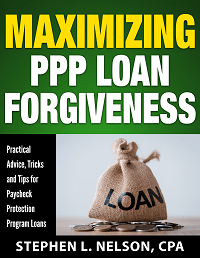Nearly five million small businesses received a PPP loan, including many of your clients.
Over the next few weeks, each will apply for forgiveness through a process that resembles a combination of an IRS correspondence audit and a couple of afternoons in an algebra class.
If you’re ready to help? Great! But if you aren’t there yet, get up to speed quick and stay up to speed with our “Maximizing PPP Loan Forgiveness” e-book ($100, 130 pages, up-dated October 13, 2020):
Money Back Guarantee
“Maximizing PPP Loan Forgiveness” should save you hours of time learning, help you to avoid costly mistakes, and let you jack up the value you deliver clients.
The e-book also includes an appendix accountants, attorneys and bankers can turn into a paper or pdf resource they freely distribute to clients and customers.
However, if the e-book doesn’t deliver the value you expected or needed? Just email us, and ask for a refund. No questions asked. No problems.
Update-t0-date as of October 13, 2020
The e-book is up-to-date as of October 13, 2020, and it includes coverage of the de minimis rule for small borrowers and the simple 3508S forgiveness application.
Share e-Book with Four Co-workers
Everyone in your office needs to be up-to-speed on the PPP. Accordingly, we want you to share your e-book pdf with up to four of your staff accountants or administrative staff. Sharing with your c0-workers is okay with this e-book! Everyone will need to pitch in with the PPP forgiveness season we all have coming up…
Table of Contents
Need more details about what the book covers? Here’s the list of chapters with descriptions of their contents:
- Chapter 1, “The PPP Formulas in a Nutshell,” explains how the PPP loan amount gets calculated and in a general way how a borrower receives forgiveness.
- Chapter 2, “Paid or Incurred Accounting,” describes how to use the “new” accounting method mandated by the SBA’s rules. This chapter also explains what covered periods are.
- Chapter 3, “Payroll and Related Costs,” describes how the payroll costs and owner compensation costs lead to forgiveness.
- Chapter 4, “Mortgage Interest, Rent and Utilities,” describes which non-payroll costs potentially lead to forgiveness of the PPP loan.
- Chapter 5, “FTE, Salary and Wage Reduction Adjustments,” explains how the PPP forgiveness formula may reduce forgiveness if a firm reduces its employee count or pay rates.
- Chapter 6, “Tax Accounting for PPP Loans,” walks readers through the steps for tracking PPP loans and then handling the tax accounting correctly.
- Chapter 7, “Loan Forgiveness using 3508EZ Application,” explains how the PPP loan forgiveness process works and how a borrower asks for forgiveness using the simple “EZ” form.
- Chapter 8, “Loan Forgiveness using 3508 Application,” walks a borrower through the steps of completing the longer “full-sized” loan forgiveness application including its Schedule A form and worksheet. A borrower uses the long form application when it needs to deal with adjustments in the forgiveness due to changes in employment levels or pay rates.
- Chapter 9, “Tips and Tricks,” points out some key things that borrowers want to do to simplify the forgiveness application process and to maximize the forgiveness they receive. In effect, Chapter 9 summarizes the really important bits of the preceding chapters.
More Information About Author
CPA Stephen L. Nelson is the managing member of Seattle-area CPA firm that specializes in serving privately held companies with multi-state and international operations as well as their owners. A CPA for three-plus decades, Nelson holds an MBA in finance from the University of Washington and an MS in tax from Golden Gate University. A former adjunct tax professor at Golden Gate University, he is also the author of numerous reference books including the bestselling QuickBooks for Dummies and Quicken for Dummies titles both of which sold more than 1,000,000 copies.
